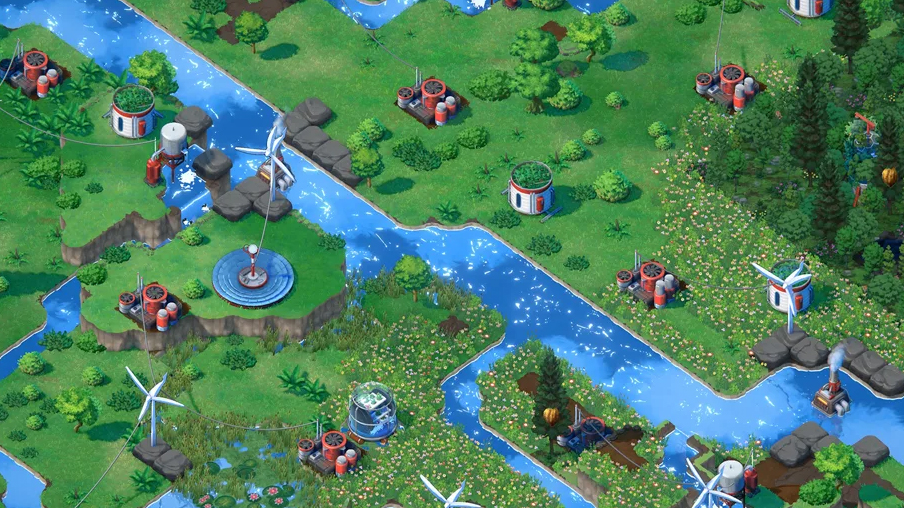Transforming a barren wasteland into a leafy green paradise feels damn good in Terra Nil
Build machines to help restore nature and create biodiversity, then pack them up and fly away in this strategy sim.

Terra Nil's demo presents you with a dead and barren square of land. A few dry river beds, a couple rotting timbers of wood, a few rocks here and there. That's all there is. But place a wind turbine on a sturdy rock, use it to power a toxin scrubber to rejuvenate the poisoned soil, place an irrigator to water the area, and bright green grass begins to grow.
Place water pumps in river beds and sparkling blue water appears. Dig new channels in the earth with a mortar launcher and the water will flow further, growing new grass along the riverbanks. A calcifier will use water to create new stone outcroppings where you can place more wind turbines. Slowly you spread your helpful technology across the dead map and bring it new life.
Transforming a barren landscape into a pasture is relaxing and pleasing, but it also takes some forethought and strategy. Each machine costs a certain amount of points, and you can only earn more points by reclaiming areas of the map, so you have to consider the placements of your machines carefully to maximize the return on each. Helpfully, there's an undo button that lets you take back your last move in this game of terraforming chess, but it can still be a bit tricky at times. If you run out of points, you have to start over.
Once most of the map is nice and green, a new tier of machinery unlocks, along with a new challenge: create some biodiversity. Grass is great, but it's only the start. A hydroponium can be placed alongside a river to create a wetland area. A solar amplifier can provide enough sunlight so a few trees can grow instead of just grass. If you have a tree, you can pop on a beehive which will help flowers spread across the green fields. And once you've got a healthy patch of plains, it's time to set it on fire.
Yes, destructive as fires can be, they're still an important part of nature. Burning your pasture will enrich the soil and allow real forests to grow. And bringing real biodiversity to the map means increasing the three biomes of wetlands, pastures, and forests in equal measure.
Once I've got a nice balance of new biomes, I put down a few weather devices to increase the temperature and humidity until it's in the ideal range for this lush new habitat. And the rewards come when I see the first tiny flock of birds gliding over my little patch of restored nature. Frogs start hopping in the wetlands and fish start to populate my rivers. A tiny herd of deer nibbles at the bushes growing on the plains. It's delightful.
With the natural balance restored, it's time to pack up all those machines I built—playing a city-builder but in reverse. I place recyclers around the map close to my equipment and watch them get broken down into parts. My retrieval boat glides down the waterways and collects all my junk, which is used to build an airship. Once every last bit of metal has been collected from my machines, my ship takes off—sending down a line to pick up my retrieval boat, too, of course. We're leaving nothing behind. My airship hovers away, leaving no trace that I was ever even there. All that's left is a beautiful lush landscape.
Keep up to date with the most important stories and the best deals, as picked by the PC Gamer team.
The Terra Nil demo is now available on Steam as part of Next Fest, if you'd like to enjoy it for yourself. It's a small slice of the game, but an extremely satisfying one.

Chris started playing PC games in the 1980s, started writing about them in the early 2000s, and (finally) started getting paid to write about them in the late 2000s. Following a few years as a regular freelancer, PC Gamer hired him in 2014, probably so he'd stop emailing them asking for more work. Chris has a love-hate relationship with survival games and an unhealthy fascination with the inner lives of NPCs. He's also a fan of offbeat simulation games, mods, and ignoring storylines in RPGs so he can make up his own.

